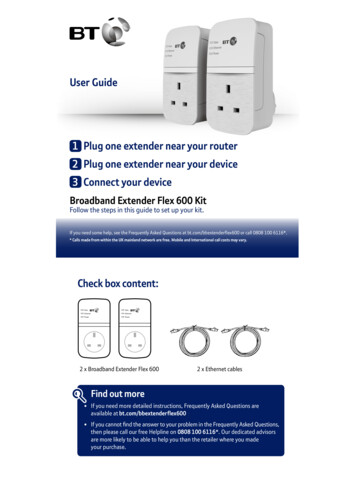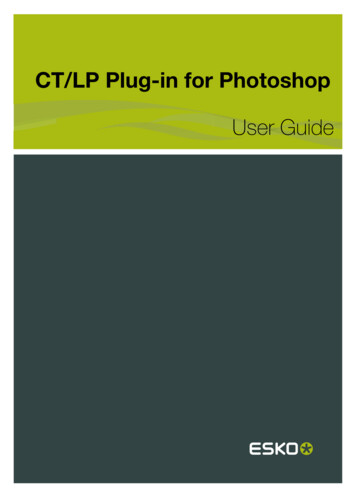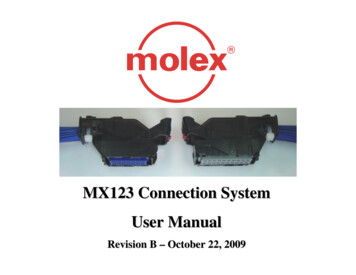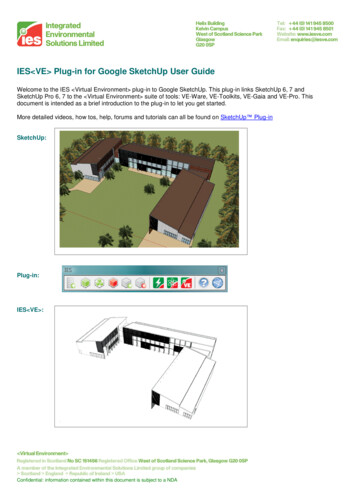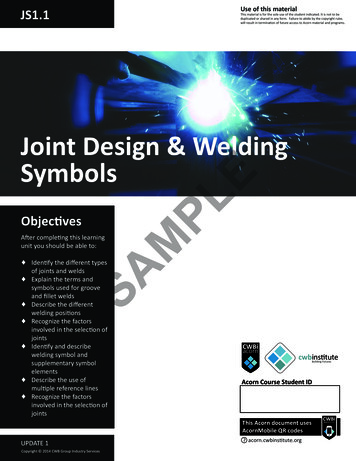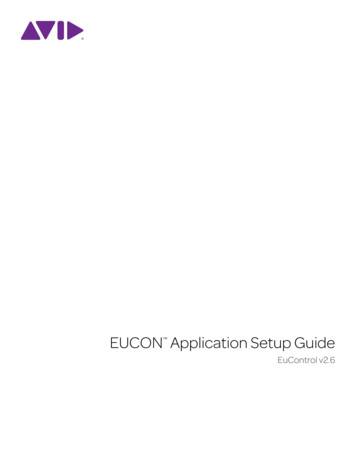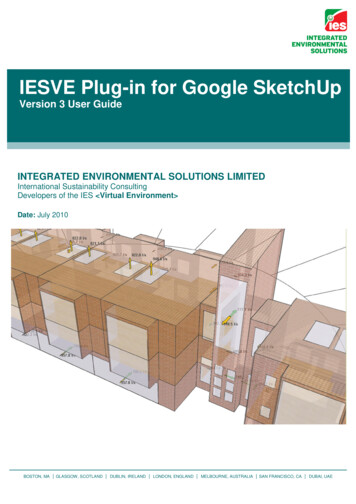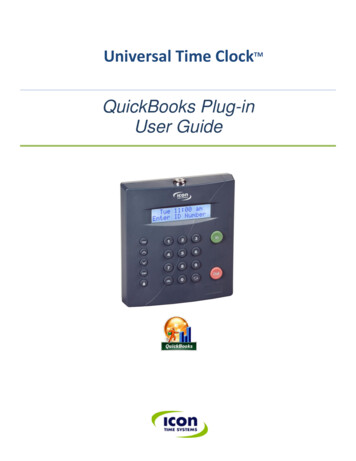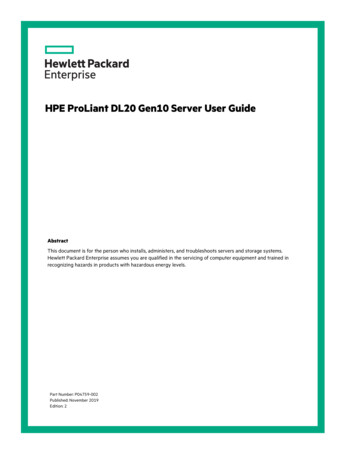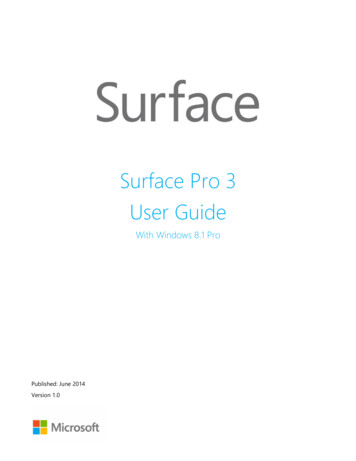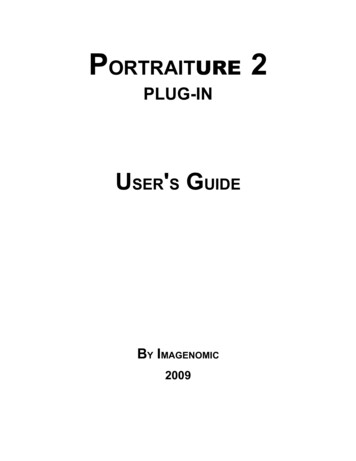
Transcription
PORTRAITURE 2PLUG-INUSER'S GUIDEBY IMAGENOMIC2009
Portraiture 2 Plug-in User's GuidePortraiture 2 Plug-in User's GuideUpdated August 10, 2009Contact Imagenomic at http://www.imagenomic.com/contactCopyright 2004-2009 Imagenomic, LLC. All rights reserved.Portraiture Plug-in for Lightroom uses the FreeImage open source image library. See http://freeimage.sourceforge.net fordetails. FreeImage is used under the FIPL, version 1.0 e.txt).Portraiture Plug-in for Lightroom uses the Little CMS library. See http://www.littlecms.com/ for details. Little CMS is usedunder the MIT License Agreement p).2Copyright 2004-2009 Imagenomic LLC. All rights reserved.All product and company names referenced herein are trademarks of their respective owners.
TABLE OF CONTENTSIntroduction.5Technical Support.5Installation.7Requirements.8Running Portraiture Plug-In.9Running from Photoshop.9Running from Aperture.10Running from Lighroom.11Installing License Key.12Key Features .13Detail Smoothing.14Skin Tones Mask.14Enhancements.14Basic Use .15Using Default Preset.16Using Predefined Presets.17Preset Thumbnail View.18Filter Preview.19Preview window navigation controls.20Navigator Window.20Advanced Use.21Fine-Tuning Portraiture.22Filter controls.22Copyright 2004-2009 Imagenomic LLC. All rights reserved.All product and company names referenced herein are trademarks of their respective owners.3
Portraiture 2 Plug-in User's GuideDetail Smoothing.22Skin Tones Mask.23Enabling Skin Tones Mask.23Auto-Mask.24Manual Mask.24Mask Preview.26Output options.27Enhancements.28Saving settings to create new filter presets.28Managing Presets.29Undo/Redo (History).30History Preview.31Multiple Previews and Bracketing.32Multiple Previews.32Bracketing.33Preferences.35Resizing Portraiture Plug-in Window.37Photoshop Action And Scripting Support.37Multiple Image Editing with Aperture And Lightroom.37Keyboard and mouse controls.384Copyright 2004-2009 Imagenomic LLC. All rights reserved.All product and company names referenced herein are trademarks of their respective owners.
IntroductionINTRODUCTIONSimply put, Portraiture helps you portray people the way people wish to portraythemselves. The wrinkles around smiling eyes convey the dark circles mightconvey something else. Portraiture helps keep and signify the true features of theportrait while smoothing and neutralizing the trivial blemishes and imperfections ofhuman appearance (but not of human nature).Portraiture eliminates the tedious manual labor of selective masking and pixel-bypixel treatments to help you achieve excellence in portrait retouching. Itintelligently smoothens and removes imperfections while preserving skin textureand other important portrait details such as hair, eyebrows, eyelashes etc.For finer control, you can specify the smoothening degree for different detail sizesand across skin tones using a powerful masking tool as well as adjust thesharpness, warmth, brightness and contrast. You can also quickly produce a“glamour” and other stylized effects.Portraiture’s controls are simple and easy-to-use, enabling a truly intuitiveworkflow. It comes with pre-defined presets for one-click effects and, as with allImagenomic plug-ins, you can capture your own signature workflow in a custompreset tailored to your specific requirements and photographic portfolio.TECHNICAL SUPPORTTechnical support is available via Imagenomic’s website athttp://www.imagenomic.com/supportCopyright 2004-2009 Imagenomic LLC. All rights reserved.All product and company names referenced herein are trademarks of their respective owners.5
Portraiture 2 Plug-in User's GuideTHIS PAGE IS MOSTLY BLANK6Copyright 2004-2009 Imagenomic LLC. All rights reserved.All product and company names referenced herein are trademarks of their respective owners.
InstallationINSTALLATION REQUIREMENTS INSTALLING LICENSE KEY RUNNING PORTRAITURE PLUG-INCopyright 2004-2009 Imagenomic LLC. All rights reserved.All product and company names referenced herein are trademarks of their respective owners.7
Portraiture 2 Plug-in User's GuideREQUIREMENTSPortraiture Plug-In works with both 8-bit and 16-bit images and is compatible withAdobe Photoshop CS2/CS3/CS4, Adobe Photoshop Elements 4/5/6/7, AdobeLightroom 2 and Apple Aperture 2.1.The following are the minimum system requirements:8 Microsoft Windows XP/Vista 1GB free RAM 100MB free hard drive space 1280x800 screen resolution Mac OS X 10.4.x /10.5.x 1GB free RAM 100MB free hard drive space 1280x800 screen resolutionCopyright 2004-2009 Imagenomic LLC. All rights reserved.All product and company names referenced herein are trademarks of their respective owners.
InstallationRUNNING PORTRAITURE PLUG-INRunning from PhotoshopFor Adobe Photoshop and Adobe Photoshop Elements click on the Filter menuand select Imagenomic PortraitureFigure 1: Running Portraiture Pug-in from Adobe Photoshop CS3Copyright 2004-2009 Imagenomic LLC. All rights reserved.All product and company names referenced herein are trademarks of their respective owners.9
Portraiture 2 Plug-in User's GuideRunning from ApertureTo run the plug-in from Aperture, right-click on the image and select Edit With- Portraiture Plug-in.Figure 2: Running Portraiture Pug-in from Apple Aperture10Copyright 2004-2009 Imagenomic LLC. All rights reserved.All product and company names referenced herein are trademarks of their respective owners.
InstallationRunning from LighroomTo run the plug-in from Aperture, right-click on the image and select Edit In- Imagenomic Portraiture.Figure 3: Running Portraiture Pug-in from Adobe LightroomCopyright 2004-2009 Imagenomic LLC. All rights reserved.All product and company names referenced herein are trademarks of their respective owners.11
Portraiture 2 Plug-in User's GuideINSTALLING LICENSE KEYTo install the license key open the "About Portraiture" window by clicking on the"About" button and click on the "Install License" button. The "License KeyInstallation" window will show where you can enter your license information.Figure 4: License key installation window12Copyright 2004-2009 Imagenomic LLC. All rights reserved.All product and company names referenced herein are trademarks of their respective owners.
Key FeaturesKEY FEATURES DETAIL SMOOTHING SKIN TONES MASK ENHANCEMENTSCopyright 2004-2009 Imagenomic LLC. All rights reserved.All product and company names referenced herein are trademarks of their respective owners.13
Portraiture 2 Plug-in User's GuideDETAIL SMOOTHINGPortraiture smooths and softens an image by removing artifacts and preservingskin texture and other important image details such as hair, eyebrows, eyelashesetc. You can specify the smoothing degree for different detail sizes – fine, mediumand large. Portrait size can also be specified or automatically detected based onthe image dimensions.SKIN TONES MASKPortraiture features a powerful skin tone masking tool to allow for a finesmoothening control across all skin tones which are present in the image.ENHANCEMENTSPortraiture provides several controls to further enhance your portraits. You canadjust the sharpness, softness, warmth, brightness and contrast.14Copyright 2004-2009 Imagenomic LLC. All rights reserved.All product and company names referenced herein are trademarks of their respective owners.
Basic UseBASIC USE DEFAULT PRESET USING PRESETS PREVIEW AND CONTROLSCopyright 2004-2009 Imagenomic LLC. All rights reserved.All product and company names referenced herein are trademarks of their respective owners.15
Portraiture 2 Plug-in User's GuideUSING DEFAULT PRESETWhen you start Portraiture Plug-in for the first time, the filter is set to the "Default"setting. The main preview window will automatically display a copy of your imageprocessed at the "Default" setting. The “Default” setting resets all control settingsto their respective zero (0) or other default position. You can further adjust it usingthe many controls. You can examine the result, which will be automaticallyrendered in the preview area by using the zoom, split-screen and panning tools aswell as compare your processed image with the original by using click (and hold)with the left mouse button in the preview area.Figure 5: Portraiture at the “Default” setting16Copyright 2004-2009 Imagenomic LLC. All rights reserved.All product and company names referenced herein are trademarks of their respective owners.
Basic UseUsing Predefined PresetsIn addition to the "Default" setting, Portraiture provides ten predefined settingpresets fine-tuned for various effects. For example, for specifying skin smoothinglevel, you would use the respective presets such as “Smoothing: Normal”,“Smoothing: Medium” or “Smoothing: High”.Portraiture also provides additional special effect presets such as “Glamour”,“Enhance Tones”, “High Key” and “Low Key”. These out-of-box presets can serveas a starting point for arriving at the desired results - you can further fine-tune thesettings by operating the corresponding sliders. Generally on start-up Portraiturewill default to the last used filter settings.Figure 6: Portraiture predefined setting presetsCopyright 2004-2009 Imagenomic LLC. All rights reserved.All product and company names referenced herein are trademarks of their respective owners.17
Portraiture 2 Plug-in User's GuidePreset Thumbnail ViewFigure 7: Preset thumbnail viewPreset drop-down tree also provides additional “Thumbnail” view. This mode willrender the image thumbnail in real-time to show Presets' preview before it isapplied.18Copyright 2004-2009 Imagenomic LLC. All rights reserved.All product and company names referenced herein are trademarks of their respective owners.
Basic UseFILTER PREVIEWThe preview window displays a processed copy of the image. Portraiture updatesthe visible part of this preview in real-time when you apply a filter setting or modifyany individual parameter. Once the filtering operation is completed you can click(and hold) on the processed image with the left mouse button to view the originalimage or to use panning. To zoom, you can use the [-]/[ ] buttons located underthe preview window. The zoom value can vary from 10% to 800%. When zoomingout, the processing speed can degrade as the preview will have to handle largernumber of pixels. To speed up the preview update, you can choose “Fast Preview”which may slightly affect the preview accuracy. Choosing “Accurate” will show theexact result of the final processing.In addition you can view the image in a horizontal or vertical split mode withoriginal (top or left window section) and processed (bottom or right windowsection) copies both visible in the main window area. Analogous to the single viewmode, you can click to pan or to see the original image.Figure 8: Filter Preview in vertical split mode zoomed at 25%Copyright 2004-2009 Imagenomic LLC. All rights reserved.All product and company names referenced herein are trademarks of their respective owners.19
Portraiture 2 Plug-in User's GuidePreview window navigation controlsIn addition to mouse panning, you can use the mouse wheel to scroll vertically andCtrl-wheel to scroll horizontally. You can also zoom using the Alt-Wheel. Zoom-incan be also activated with Ctrl-click and zoom-out with Alt-click. Right-click on thepreview image area will display a context pop-up menu with zoom, display modeand tool selection.NAVIGATOR WINDOWThe Navigator window allows for navigating the image by dragging the red squarecursor or by clicking on a different area of the image. The corresponding area ofthe image is then displayed in the main preview window.Figure 9: Navigator window andPreview Mode20Copyright 2004-2009 Imagenomic LLC. All rights reserved.All product and company names referenced herein are trademarks of their respective owners.
Advanced UseADVANCED USE FINE-TUNING PORTRAITURE MULTIPLE PREVIEWS AND BRACKETING DETAIL SMOOTHING SKIN TONES MASKING ENHANCEMENT CONTROLS PHOTOSHOP ACTION AND SCRIPTINGSUPPORT KEYBOARD AND MOUSE CONTROLSCopyright 2004-2009 Imagenomic LLC. All rights reserved.All product and company names referenced herein are trademarks of their respective owners.21
Portraiture 2 Plug-in User's GuideFINE-TUNING PORTRAITUREFilter controlsPortraiture filter control sets provide a wide range of fine-tuning depending on thespecific image requirements. In addition to the default and other presets that comepredefined with Portraiture, you can adjust any of the controls to fine-tune yourcustom filter configuration for the desired results. The controls are grouped intothree functional sets – “Detail Smoothing”, “Skin Tones Mask” and“Enhancements” controls - to enable intuitive and effective processing. Each set isexplained in more detail in the following sections.Detail SmoothingPortraiture smooths and softens an image by removing artifacts while preservingskin texture and other important image details such as hair, eyebrows, eyelashesetc. To achieve the desired result, you can adjust the smoothing degree fordifferent detail sizes – fine, medium and large. Also, the details to be smoothenedare determined by the threshold value: the higher the threshold value, the higherdegree of image details that will be smoothened.Figure 10: Detail Smoothing controlsDepending on the “Portrait Size” Portraiture adjusts the smoothening parametersto achieve the most visually compelling result. Portrait size can be automaticallydetected based on the image dimensions – roughly Small for less than 4MPixels,Medium for between 4MPixels and 10MPixels, and Large for over 10MPixels; or,alternatively, you can manually select the portrait size.22Copyright 2004-2009 Imagenomic LLC. All rights reserved.All product and company names referenced herein are trademarks of their respective owners.
Advanced UseIf manually selected, the “Small (4x6-5x7)” setting should be used if the image isalready resized for small print (4X6 or 5X7), web or screen view. The “Medium(8x10-11x16)” and “Large (11x16 and larger)” should be used if the image isalready resized for printing 8x10 (or similar size prints), or for larger print sizes.The smoothing degree can be controlled separately by spatial characteristic of theimage details (Fine, Medium and Large).Skin Tones MaskEnabling Skin Tones MaskPortraiture provides a powerful skin tone masking tool to allow for a finesmoothening control across all skin tones present in the image when therespective check-box is selected.The Mask allows to apply the smoothening only to the skin areas of the portraitthus ensuring against unnecessary smoothening of other parts of the image.Figure 11: Skin Tones Mask controlsCopyright 2004-2009 Imagenomic LLC. All rights reserved.All product and company names referenced herein are trademarks of their respective owners.23
Portraiture 2 Plug-in User's GuideAuto-MaskWhat makes Portraiture’s masking tool truly unique is its built-in Auto-Maskfeature. It is a nifty skin tone detection algorithm that employs sophisticated colorand tonal analysis and intelligence to recognize the skin tone range of the imageautomatically and, accordingly, to create an optimal skin tones mask for aparticular image.Auto-mask becomes especially handy when batch processing. Because it cancreate the masks automatically based on each image's unique skin tone range,each image will be treated individually during the batch process; this is quite anefficient workflow technique when you choose applying detail smoothening only toskin tones to a large number of images.Auto-Mask helps you quickly discover most of the skin tone range of the imageand, if the resulting mask is not satisfactory, you can manually fine-tune it toensure optimal results, providing unmatched precision and productivity.Auto-Mask is activated by default whenever the “Apply Detail Smoothing to SkinTones Only ” option is checked. You can choose between two settings for thiscontrol: “New From Image” which will generate an auto-mask based on the currentimage, or “Last Used” to re-use the mask that was generated earlier and used last.The Auto-Mask is essentially a default starting point when processing a particularimage as determined by the skin tone detection algorithm when you select “NewFrom Image” or by “Last Used” mask. The Auto-mask can be always fine-tuned oroverridden by manually adjusting the masking controls.Manual MaskFor manual mask definition and fine-tuning, Portraiture provides two Color Pickertools, a Pick Mask Color and an Expand Mask Color for defining the Mask's toneand color range based on the skin tones of the image as represented by theselected pixel. When using either of these tools, you can view the selected pixelparameters displayed on the right-hand side of the plug-in window indicatingwhether the selected tone is within the Skin Tone range.When the Pick Mask Color is used the mask range is determined by the singlepixel. When the Expand Mask Color is used each, subsequent selected tonevalues are combined with the current mask to produce a new tone range.The resulting mask range is shown in the Skin Tone Range monitor on the lefthand side of the plug-in window. You can operate the respective controls on themonitor itself or the sliders underneath it in order to set the Hue, Saturation andLuminance of the desired Skin Tone Range. The Latitude value determines thewidth of the mask range around the adjusted and/or selected tone. In other wordsthe latitude value determines the sensitivity of the mask vis-a-vis the selected skincolor value.24Copyright 2004-2009 Imagenomic LLC. All rights reserved.All product and company names referenced herein are trademarks of their respective owners.
Advanced UseFigure 12: Skin Tones Mask PreviewYou can view the resulting mask on white or black background by choosing therespective radio-box.The Opacity control sets the degree of the masking with respect to the remainingareas of the image outside of the mask range. For example, 100% opacity valuewill not apply any of the smoothening to the areas of the image that are not withinthe mask range while 0% setting will ignore the mask completely.The Fuzziness control allows for refining the mask selection by narrowing downthe color selected range.The Feathering control smooths the mask edges to provide a more uniform maskshape.Copyright 2004-2009 Imagenomic LLC. All rights reserved.All product and company names referenced herein are trademarks of their respective owners.25
Portraiture 2 Plug-in User's GuideMask PreviewWhen using either color picker tools, the real-time Mask Preview window willexpand on the right side of the dialog. It will show what the mask would be beforechanging the actual mask.The “Auto Expand” check box controls whether to show and hide the previewwindow automatically when picker tools are selected, or manually, by clicking onthe small rectangle icon.Figure 13: Real-time mask preview26Copyright 2004-2009 Imagenomic LLC. All rights reserved.All product and company names referenced herein are trademarks of their respective owners.
Advanced UseOutput optionsPortraiture also allows for the outputting of only the masked range of the imagewhen the respective “Create Transparency Mask” check-box on the right-handside of the plug-in window is selected. This feature requires that Portraiture isrunning on the layer with available transparency channel. Alternatively, if the “NewLayer” option is selected, Portraiture will generate a new layer and then will applythe filter on the newly created layer.Figure 14: Mask Output optionsCopyright 2004-2009 Imagenomic LLC. All rights reserved.All product and company names referenced herein are trademarks of their respective owners.27
Portraiture 2 Plug-in User's GuideEnhancementsPortraiture provides several controls to further enhance your portraits. You canadjust the sharpness, warmth, brightness and contrast, as well as soften toproduce a glamour effect.The combination of brightness and contrast controls allow for adjusting thebrightness and contrast without over blowing highlights or over darkening theshadows.The warmth control adjusts the skin color saturation to emulate different skin tonesfrom pale to tan.The Tint control changes the hue of skin color tones towards reds (negative) oryellows (positive).When “Use Mask” check-box is selected, all enhancements (except for Sharpnessand Softness) are applied only to the area selected by the Skin Tones Mask.Saving settings to create new filter presetsYou can create your own custom presets by clicking the "Save Settings" button.You can choose to save the custom settings from each or any combination of thethree control sets. Custom Presets can be saved in Groups (e.g. For specificclients or assignments) and can be annoted with additional details.Figure 15: Save, Presets, Undo and Redo buttons28Copyright 2004-2009 Imagenomic LLC. All rights reserved.All product and company names referenced herein are trademarks of their respective owners.
Advanced UseFigure 16: Save Filter Settings WindowManaging PresetsThe Preset Manager window, which is accessible by clicking on the “Presets”button to the right of the “Save” button, allows for the renaming, deleting andexporting/importing of presets. The location for saving presets can also bedesignated, e.g. In a specific folder on a local drive or on a network drive forsharing between multiple users.Copyright 2004-2009 Imagenomic LLC. All rights reserved.All product and company names referenced herein are trademarks of their respective owners.29
Portraiture 2 Plug-in User's GuideFigure 17: Preset ManagerUndo/Redo (History)You can revert or re-apply the last settings used by clicking the “Undo.” and“Redo.” button controls next to the preset combo-box or by using CTRL Z orCTRL Y keyboard combinations respectively. These controls can be alsoaccessed by right-clicking on a slider control.Undo/Redo will apply to setting changes made at least half a second apart fromeach other.30Copyright 2004-2009 Imagenomic LLC. All rights reserved.All product and company names referenced herein are trademarks of their respective owners.
Advanced UseFigure 18: History drop-down listHistory PreviewEach recorded history state can be previewed as an individual thumbnail.Figure 19: History thumbnail viewCopyright 2004-2009 Imagenomic LLC. All rights reserved.All product and company names referenced herein are trademarks of their respective owners.31
Portraiture 2 Plug-in User's GuideMULTIPLE PREVIEWS AND BRACKETINGMultiple PreviewsThe Portraiture preview feature provides a mechanism for opening multiplepreview windows, up to 100 for the same image file. This allows you to comparedifferent filter settings by simply switching between preview tabs. The filter settingswill be automatically set to their respective values for each preview.To create a preview, click on the "Add Preview" button. To close a preview, select"Close Preview" from the context popup menu and the current preview will beclosed. You can also "Close Other Previews" which will close all other previewsand keep only the current preview.Figure 20: Preview popup menu32Copyright 2004-2009 Imagenomic LLC. All rights reserved.All product and company names referenced herein are trademarks of their respective owners.
Advanced UseBracketingIn addition to creating custom multiple previews, Portraiture provides anautomated bracketing feature for quickly generating a series of previews forvarious filter settings. For each original setting, the bracketing creates theselected number of previews with the specified bracketing interval.To bracket or to set up a bracketing preset, click on the “Bracketing” button. Youcan choose to replace already open previews or add the new previews to theexisting tabs.Figure 21: Parameter bracketing windowOnce the preset is created, it will appear in the same menu selection. When usingbracketing, you can view the name of the respective bracketing parameter and itsabsolute value on the preview tabs. A tab will also reflect custom changes made tothe bracketing parameters values for a given preview. In addition, the mouse rollover of any inactive preview tab will display a tool tip that will specify theparameter value differences relative to the parameter values of the currently openCopyright 2004-2009 Imagenomic LLC. All rights reserved.All product and company names referenced herein are trademarks of their respective owners.33
Portraiture 2 Plug-in User's Guidepreview. Bracketing can be also activated by right-clicking on the respective slidercontrols in the Filter section.Figure 22: Bracketing Parameter Name and values in preview tabs and Right-click pop up menuwith bracketing options34Copyright 2004-2009 Imagenomic LLC. All rights reserved.All product and company names referenced herein are trademarks of their respective owners.
Advanced UsePREFERENCESThe Preferences window is accessible from the “About” window by clicking on the“Preferences” button. There are three sections - “Skin Tones Mask”, “Interface”and “Performance”.The “Skin Tones Mask” section provides defaults for the mask color picker tools.The “Center-Weighted “Auto Mask”” option indicates whether to use the entireimage or only the center of the image for mask calculation. This option can behelpful for batch processing multiple portraits, creating more accurate skin tonesmasks.The “Interface” section is for changing the foreground and background colors ofthe plugin dialog window.The Performance section allows for the manual selection or automatic detectionand use of multiple CPUs on the host system.Copyright 2004-2009 Imagenomic LLC. All rights reserved.All product and company names referenced herein are trademarks of their respective owners.35
Portraiture 2 Plug-in User's GuideFigure 23: Skin Tones Mask optionsFigure 24: User Interface preferences36Copyright 2004-2009 Imagenomic LLC. All rights reserved.All product and company names referenced herein are trademarks of
Aug 10, 2009 · Portraiture 2 Plug-in User's Guide REQUIREMENTS Portraiture Plug-In works with both 8-bit and 16-bit images and is compatible with Adobe Photoshop CS2/CS3/CS4, Adobe Photoshop Elements 4/5/6/7, Adobe Lightroom 2 and Apple Aperture 2.1. The following are the minimum syst
